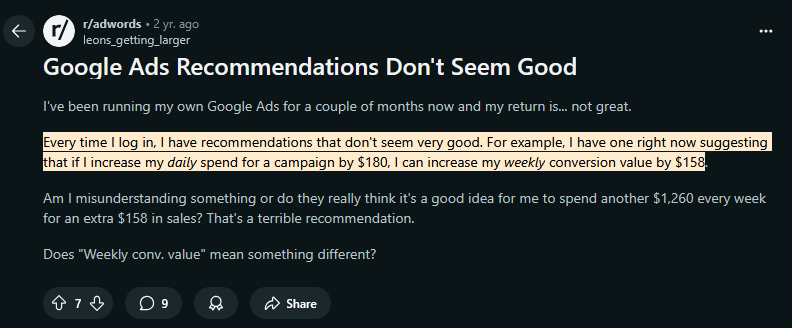On the surface, online advertising looks pretty straightforward. You set a budget, you choose an audience, put together some copy and creative, and watch the leads come in.
Then reality hits. And you run into all kinds of weird behavior, confusing metrics, AI “assistance,” and other fine print oddities that can derail your day.
This post is a crash course in the things that nobody tells you upfront. I’m talking about all the strange little quirks and frustrations that you’ll run into on platforms like Google, Meta, and more. And, yes, all of this has happened to me at some point in the last seven years.
Whether you’re running your own campaigns or managing them for clients, you’ll want to read this before you shovel dollars into ads.
But real quick, I want you to know: I love online ads.
Online advertising can be effective. Especially if you approach it with a rigorous, scientific mindset. I’ve run plenty of campaigns that have had serious ROI.
But success depends on more than just creative and targeting. You have to understand how these platforms behave. Not just what the documentation says.
That means you need to budget for click fraud, recognize when suggestions are upsells, and know which metrics are helpful and which aren’t.
So if you’ve ever looked at yours ads and wondered why you’re reporting “28 conversions” when you’ve had two phone calls or your Amazon ads spent $6.57 of their $400 budget—this one’s for you.
Like what you’re reading so far? Subscribe for more!
1. Online ads can spend way more than you expect.
You might think that your daily budget is a binding limit. It’s not.
Google can spend up to twice your daily cap, and Meta will go 25% over if it thinks that day will perform better. The industry term for this is “budget smoothing,” but if you’re not watching closely, your spend can spiral fast.
A $50/day Google ads campaign might suddenly cost $80 or more. It adds up over time, especially if you’re trying to manually stop or start campaigns.
The platforms say they average it out over the month, and this is true. But on a tight budget or with irregular performance, those kinds of spikes can cause problems.
And unless you keep a really close eye on the spending, you might not even notice until you (or your client) ends up paying for a charge.

Weirder still? I actually think this is a good thing, since it means the system can save you money on Saturday and Sunday if it notices that people are looking for you primarily on the workweek.
But only if you know this is happening!
2. Online ads can refuse to spend your budget.
Campaigns sometimes flat-out refuse to spend, even when you’re willing to throw money at them. There have been a few times where I’ve launched new ads, set a really healthy daily budget, and waited only to find that…nothing happened.
The system might say “limited learning” or it might simply show no impressions or a very small amount of impressions. And if you don’t know what you’re looking at, it’s awfully perplexing.
This can happen if your targeting is too narrow, your bid is too low, or the algorithm just can’t find people it thinks will convert.
And fun fact: the platform you use won’t always tell you why.
You’ll just see a campaign stuck, waiting for it to spend. It’s a bit like watching paint dry. And, of course, it’s tough to explain to clients or stakeholders.
The fixes aren’t always obvious either. Sometimes all you can do is loosen targeting or just rebuild the campaign from the ground up.
3. You have to prove you are who you say you are.
At some point, usually after your ads start running, Google or Meta will ask you to verify your identity or business. If you ignore the prompt, they’ll pause your campaigns.
The process can be painfully slow: expect to upload documents (including things like U.S. passports!), wait patiently, and maybe repeat the whole thing if something doesn’t match exactly. It feels less like onboarding and more like applying for a mortgage.

And how long will you be staying in “Meta-Land”?
It gets odder still. Once verified, your legal business name (or even your personal name) might appear in a transparency notice on your ads. This is meant to build trust with users, but it can surprise solo advertisers who suddenly see their name and location publicly attached to every campaign. It's not optional, and it can take weeks to resolve.
So please double-check and make sure your info isn’t showing up where it shouldn’t!
4. It’s harder than you think to track conversions.
I’ve written before about the absolute state of conversion tracking in 2025.
Tracking conversions sounds easy: someone clicks your ad, they land on your site, and buy something. But the reality is messier.
Clicks don’t always result in visits—maybe the user bounces before the page loads, or tracking scripts don’t fire properly. Even when everything “works,” the numbers often don’t add up. It’s not uncommon to see hundreds of clicks but only a handful of actual landing page views. If your site is slow or your user has strong privacy settings or an ad blocker, it can mess up your ad system’s reporting.
Worse, if your tags aren’t properly installed across your funnel, you might miss conversions entirely. Good tracking takes regular audits, testing, and a little humility.
Because truth is, even when you think it’s working, odds are it's not catching everything.
5. Attribution often counts conversions that it shouldn't.
Most ad platforms use attribution models that lean heavily in their favor. View-through conversions, just to give you one example, give credit to ads that someone merely saw but didn’t click. Sometimes days or weeks before a sale.
Think about that one for a second.
A customer might click a Facebook ad on Monday, a Google ad on Wednesday, and finally buy on your site Friday after typing in the URL directly.
So Facebook will take credit. And so will Google. And Shopify might just track it as an organic conversion!
The end result are inflated conversion numbers that don’t reflect what truly flipped the “buy this” switch in the customer’s head. You need some kind of way to remove duplicates if you want to get a sense of what’s really going on.
6. Every ad system has its own quirky, made-up metrics.
Ever heard of an “optimization score” or “ad recall lift”? They sound official but are often black boxes: you don’t know how they’re calculated, they vary wildly, and they rarely translate into real business results.

These metrics exist largely to justify spend or steer you toward platform-preferred behavior. Now that’s not to say they’re useless. But they shouldn’t be taken at face value either.
Focus on what matters: cost per qualified lead, sales, and actual ROI. If a metric can’t be explained without a whiteboard and a PhD, it probably isn’t helping you make smarter decisions.
7. Platform suggestions to improve ads are often upsells in disguise.
Inside every ad account dashboard is a "recommendations" tab begging for attention. Google might suggest raising your budget by 50%, or turning on broad match keywords. Meta might push you to expand your audience or loosen placements.
While some suggestions are worth testing, many are just ways for the platform to increase your ad spend under the banner of optimization.

Here’s how you can spot unhelpful suggestions: they’re usually framed as a way to make your campaign "healthier," which triggers a sense of urgency. But that’s the issue: “healthier” is a vague notion when it comes to advertising.
Unless you know your numbers and goals inside out, applying these suggestions can quickly lead to wasted budget.
8. Built-in AI suggestions are usually not good either.
Ad platforms have all kinds of neat AI tools in them. Some work better than others, and if you’ve ever actually used them, you probably already know: most built-in suggestions feel…off.
Google might push you toward Performance Max or broad match keywords even if they make no sense for your business. Meta’s default is to roll everything into Advantage+ placements. Both of these steer your campaigns more in the direction of letting Google and Meta decide what’s best, which is often not the right call.
And the issue here is that the platforms don’t get the broader context you work with. You know your profit, CLV, and how seasonality impacts sales. The ad platforms don’t, so they optimize for what they do understand. Engagement and low-hanging conversions. That’s not great when you consider what I said earlier about how this information is often overcounted.
That means if you don’t take the suggestions with a grain of salt, you can end up with more clicks, but less revenue.
9. Your account can get banned suddenly and without warning or a chance to appeal.
It happens from time to time. One day you're running ads, and the next, everything's shut down. And this often comes without a warning or reason why beyond a vague email saying you violated a policy like "circumventing systems" or "misleading content."
These suspensions can happen even if you’ve done nothing wrong. Might be from an old account, mismatched domain info, or a flag from the algorithm.
Then you try to appeal it and you get a canned response or none at all.
Even agencies with solid reputations have had client accounts banned for reasons that make no sense. It’s not about intent, it’s about how the algorithm interprets your setup.
Now look, there’s no conspiracy here. No human being is reviewing these campaigns.
A lot of times unsupervised AI will check on ads, and they’ll do so without human judgment. If something looks off to them, you might wind up in trouble.
And to be clear, the risk is low, but it hurts a lot when it happens. So you may as well prepare all the same.
10. If you spend enough, account reps might call you.
Once you start spending serious money, the reps start calling. Google, Meta, even LinkedIn—if your ad budget hits a certain threshold, expect a lot of emails and phone calls from ad strategists offering help.
But it’s important to know: often these are third-party contractors with one job: get you to spend more. Their advice often just lines up with the same AI recommendations in your dashboard. They might push Performance Max, broader audiences, or higher budgets—anything that bumps your ad spend.
Sometimes, you’ll get a great rep. I’ve had this happen as well. But I’d say that’s not a super common experience.
The point is: you’re not required to work with them. And unless they’re offering something you actually want to test, you can and probably should ignore them. I’ve had good results by asking them politely to take me off their call lists.
11. Not every click is a real customer.
Clicks and interest aren’t the same thing. You could see 100 clicks on your ad, but that doesn’t mean 100 people read your landing page.
Many of those clicks are accidental, particularly on mobile where big-fingered types like me click the wrong thing. Others are curiosity clicks from people who back out immediately or realize the ad wasn’t what they expected. Some don’t even make it through a slow-loading page.
That’s why click metrics by themselves don’t mean much.
Give a bit more thought to metrics like time on page or whether someone filled out a form.
12. Spam and junk leads are very common.
Online forms are magnets for garbage if you don’t protect them. Broad targeting, especially when paired with low-friction lead forms, invites bots, spam submissions, and people with no real buying intent.
It’s not unusual to get flooded with fake names, bogus emails, or phone numbers that lead nowhere. This can have the undesirable effect of making your cost-per-lead look amazing while your sales team is fielding spam calls when they should be doing something else.

Don’t worry, you can use reCAPTCHA so your leads don’t have to click the fire hydrants to contact you.
Basic filters like reCAPTCHA, email verification, and required fields help. So does tightening your targeting to avoid the lowest-quality traffic.
But even with safeguards, some junk always slips through. Factor that in when evaluating campaign success. And if you can, find a way to track lead quality as well, even if it’s a manual process.
13. Click fraud will burn some of your budget.
Click fraud exists, and it’s pretty strange.
Botnets and click farms can and will burn through your ad budget. Sometimes it’s for profit (they run websites where they collect payouts for every click). Other times it’s sabotage from competitors. I’m not saying this is common, but it does happen.
Either way, the result is the same: spent money, no revenue.
According to Juniper Research, small businesses lose 22% of their ad budgets this way. I’ve never seen it quite so bad for my clients. Maybe that’s because we’re just plain-old lucky.
But I can tell you with personal experience that this does happen at least to some extent. Enough to matter, anyway.
Google and Meta have basic fraud detection in place, but it’s only so-so. If you see weird traffic patterns—like tons of clicks from one country or identical session behavior—you may be under attack. I’ve had good success with tightening geographic filters and manual IP filtering when stuff like this happens.
Final Thoughts
Online ads do work. Often like a charm!
You can absolutely drive real leads and sales through Google, Meta, and other platforms.
But never forget: these tools are optimized for their business models, not yours.
So temper your optimism just a hair so you can stay sharp, skeptical, and prepared for quirks that don’t show up in onboarding videos.
Some of your clicks will be fake. Some leads will be junk. Some recommendations may sound helpful but serve the platform’s goals more than yours. And if a black cat crosses your path, you might get banned without warning.
But that should not scare you away from online ads. The key here is just knowing about all the weird things that could happen.
Do that and you can run ads profitably—and avoid a lot of expensive surprises along the way.
Need help marketing your business?
Or just need someone to bounce ideas off of?
Book 30 minutes with me and we can chat!
(Yes, it’s free.)
